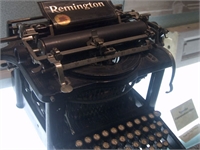
Antique Typewriter
Important Notice: Our web hosting provider recently started charging us for additional visits, which was unexpected. In response, we're seeking donations. Depending on the situation, we may explore different monetization options for our Community and Expert Contributors. It's crucial to provide more returns for their expertise and offer more Expert Validated Answers or AI Validated Answers. Learn more about our hosting issue here.
Typewriters Paved The Way For Improved Communication
Typewriters altered the social order by opening the doors of business to women, improving communication among the masses and paving the way for the computer keyboard used today. Originally known as “artificial machines that transcribed letters,” typewriters first appeared in the 18th Century. But it wasn’t until the 19th Century that an inventor was able to prove that it worked. The typewriter would go on to take its place as one of the 19th Century’s great inventions that furthered communications and technology. Alongside it: the telegraph, the telephone and photography.
Since the 19th Century, however, the typewriter has undergone numerous incarnations – actually more than three hundred different makes and models were invented, patented, or manufactured in North America.
But when it comes to antiques, there are only a few classics. Those include the Sholes & Glidden Type Writer, which was introduced in 1873 by Christopher L. Sholes, a Milwaukee newspaperman, poet and inventor. The typewriter secured its place in history by introducing Americans to the QWERTY keyboard, which is the Universal style used today. But it wasn’t perfect, typing only in Capital letters. Then, in 1878, an efficient and commercial writing machine was born. It was the Remington, model No. 2, which has become a classic antique typewriter revered by collectors.
Early typewriters came in all shapes, colors and sizes. Some were ornately decorated with flowers or cast in metals such as brass, bronze or aluminum. Some were simple with simply one wheel. Others were more complicated, featuring two keyboards. Typewriters began as manual and would later graduate to electric machines.
While the keyboard machine is the one we refer to today when we discuss typewriter a cheaper and inferior writing machine was produced. It was called an index and it used a pointer was used to select the correct letter or character on a chart. In its heyday, index machines cost as little as $5 compared to typewriters that cost roughly $100.
It’s unclear how much antique typewriters are worth since there are no catalog prices for the old machines as there are for collectibles such as coins and comic books. But an online search produced the following results: A vintage typewriter can cost anywhere between $50 for one in poor condition and $500 a rare, top-of-the-line machine in mint condition. Collectors usually invest another $100 or so in cleaning, restoring and polishing the machine at an antique repair shop. For a list of typewriter repair shops, visit http://site.xavier.edu/polt/typewriters/tw-repair.html. Or simply look up the nearest antique repair shop and ask whether they restore typewriters.
For collectors looking to buy an antique typewriter, it is not about the price or its resale value, but rather it’s a passion. Collecting vintage typewriters has become a favorite hobby for wordsmiths, authors and antique-enthusiasts alike. Most simply use the typewriters as displays of their goods. But if you visit newsrooms across America, you’ll find veteran writers still use the machine as their preferred method to write – even though the copy eventually ends up on a computer screen.